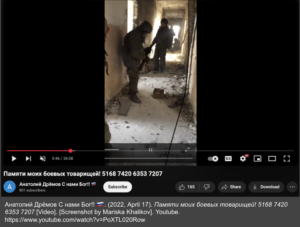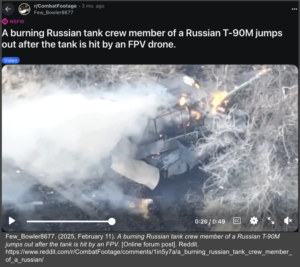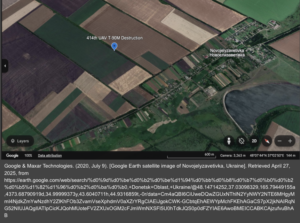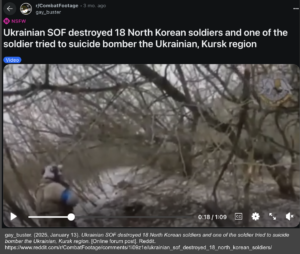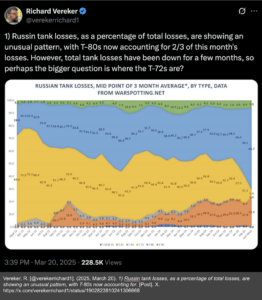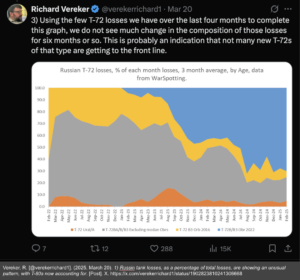Week 7: I’m Tanking This Project
Hi everyone! We’re back at it for week 7 of analyzing the role of OSINT in the Russian invasion of Ukraine. Thanks for joining me!
This week, I concluded my analysis of the role of OSINT in tactical intelligence (TACINT) for Ukraine with the conventional fight on the ground, including tank, infantry, and artillery units. For one last reminder, TACTINT is all about making decisions for soldiers in combat, so this week was about learning to make tactical decisions to counter Russian ground movements.
To begin this week, I reviewed the highlights of the Russian strategy in the ground war against Ukraine. Currently, the Russian army is following a Soviet-era tactic known as the Deep Battle doctrine (Tech4Humanity Lab at Virginia Tech, 2023). This strategy relies on breaking enemy lines with artillery fire and then penetrating with armored forces, which was clearly demonstrated in the first weeks of the invasion as Russian tanks followed artillery to gain territory in Eastern Ukraine. However, past those first weeks, the Russian strategy has failed and shifted to a reduced role of tanks on the offensive for a few reasons. First, Russian tank losses have exceeded over 70% of their prewar power. Tank battalions have blown through newer T-72 and T-90 models, forcing them to utilize stockpiles of Soviet tanks that are older and less effective. Open-source project Oryx has reported almost 4,000 tank losses, with the loss of another 8,000+ armored vehicles since the invasion. Second, because of these heavy material losses, Russian tank commands have had many junior officer casualties. Each tank is commanded by a lieutenant who has undergone five years of military schooling. Due to the lack of officers, there is a lack of leadership, communication, and morale within tank units, leading to further losses. Third, the Russian tank design makes destruction simple. Russian models, from Soviet tanks to the new 2016 iterations, lack compartmentalization of the munitions. Thus, any small fragment of a shell getting down the turret will hit the munitions storage and detonate the tank. Fourth and lastly, Ukrainian defense against tank warfare has proved effective. Anti-tank mines and anti-tank guided missiles, such as the U.S. Javelin system, have been crucial in pushing back tank penetrations (Tech4Humanity Lab at Virginia Tech, 2023). Additionally, Ukraine has effectively used drone warfare to destroy Russian tanks; thus, I saw many parallels between the TACINT collection in week 5 on the air war and this week.
The strategic shift away from offensive tank pushes by Russia has created a war of attrition where Russia has tried to wear down Ukrainian resources by outshelling them. Since tank units and infantry units often rely on each other for support and visibility, the main offensive ground force remaining for the Russians is artillery units. While researching Russian artillery, I saw tons of overlap with the briefing I am preparing for my site on North Korea. North Korea is supporting about 70% of munitions for frontline artillery units. North Korea ships around 279,000 munitions per month, allowing Russia to out-shell Ukraine 10 shells to 1.
Although Ukraine is outnumbered in artillery fire and Russian tank successes still occur, defense mechanisms facilitated by OSINT have still been able to assist Ukrainian troops. Just like the air war, cyber war, and even examples in strategic intelligence, OSINT gets frontline troops the “where” and “when” of an event in real time. Media is published at astonishing speeds, meaning constant monitoring gives out key information fast.
Aside from this overarching role of OSINT, I grouped other roles into 4 main purposes for the ground war and have provided examples of each. Click the image or see the image citation to go directly to the post website. Content Warning: Due to the subject matter, some posts will show violent images not shown in this blog post. Viewer discretion is advised.
- Testing the Attitude of a Situation: Emotion and attitude play a great role in combat, from troop morale to civilian support of either side’s operations. Emotion particularly plays a role when determining when to conduct a counteroffensive. By viewing social media data, OSINT analysts can track unit cohesion or villages that may be violent towards incoming troops. This information can inform strategies such as planning an attack when morale is low or not entering certain areas to avoid getting ambushed. An example of this testing has been used by the Ukrainian military on Russian Telegram sites. Ukrainian OSINT officers will either passively monitor data or send inciting messages to elicit emotional responses.
Anatoly Dremov’s YouTube Documentation of Russian Troops in Ukraine For a specific case of this, OSINT analysts followed the Telegram reports of Russian soldier, Anatoly Dremov. He documented his life through the invasion, including mass losses in his unit and depression among troops. His tank battalion eventually suffered a major attack, which could have been provoked by his posts. When one looks beyond the cheery demeanor in this video, Anatoly talks about losses of comrades, bad living conditions, asks numerous times for donations, and says multiple times, “you will hear less of me” and “I hope this is not the last video for everyone.” Quotes like these can test the unit’s capabilities and provide information on the effectiveness of Ukrainian offenses on these units.
- Keeping Casualty Count: In a war of attrition, it’s critical to know the numbers of enemy stockpiles to ration out resources. OSINT analysts have assisted the Ukrainian government by keeping up with satellite and social media data, allowing troops to focus on defense and not have to rely on falsified Russian reports. Several projects exist to track Russian casualties, such as Oryx and UkrWarSpotting, which both use images to keep databases of Russian equipment losses. An example of their process may look like this. A Reddit user published a video of a T-90M catching fire due to a drone strike.
Reddit u/Few_Bowler8677 Shows Russian T-90M in Flames To get more information about a location or time, I looked into the comments section to find an extended version of the video and more information in the caption.
Reddit u/MilesLongthe3rd 414th UAV Strikes the Previous T-90M From this post, I knew it was a tank battalion near the 414th UAV battalion that suffered a loss. I then went onto UAControlMap to find that on the date of the attack, the tank battalion within range of the 414th UAV was the 80th Tank Regiment. From that, I used Google map satellite imagery to place an approximate location of the casualty here.
- Combating Disinformation: Previously, we covered disinformation in strategic intelligence, but it extends into direct combat as well. Russia has constantly lied about troop and equipment use, like when satellite imaging discovered inflatable tanks were being used to draw drone fire away from functional tanks. Recently, Putin has denied the presence of North Korean troops under the Russian military in Ukraine, but OSINT reports have discounted that.
Reddit u/gay_buster Video of Ukrainian Encounter with North Korean Soldier This video portrays a Ukrainian soldier coming across a North Korean soldier in combat. The Ukrainian soldier calls out that the individual is North Korean, but the man also possibly shouts “die” (translation is unclear) in Korean before attempting suicide – an action common in reports of North Korean soldiers, whereas Russians more typically will surrender to be taken prisoner.
- Identifying Tactics and Movements: By tracking casualty count, positions, innovations, and many more categories over time, OSINT analysts can warn troops of changing Russian strategy, such as their shift away from tanks on the offensive.
@verekerrichard1 X Post: Russian Tank Losses Per Month @verekerrichard1 X Post: Percentage of T-72 Casualties In this example, an OSINT analyst has tracked Russian tank losses by tank model per month since the beginning of the invasion until March 2025. The data show a drastic decrease in the amount of T-72 casualties in recent months, so some might assume the tank’s assaults are becoming more effective. However, a connected post shows that by comparing the percentage of T-72 losses to other models over the last six months, one can see that the assaults aren’t more effective, but fewer T-72s are making it to the frontlines. This analysis can be used as evidence to demonstrate the Russian shift in offensive tank strategy and their attempt to preserve T-72 stockpiles.
I had a couple of challenges collecting this data this week, mostly created by a lack of consensus among analysts and constant changes in the battlefield landscape. One specific issue I faced this week was adjusting to the learning curve of doing image analysis. The reports I was reading drew conclusions about images quite rapidly, and I usually could not come to the conclusion they were coming to. For example, a specific image showed the attack on ammo pits, but I did not assume they were ammo pits. Mr. Franklin assured me that firstly, these analysts were most likely using advanced AI or other technology to come to these predictions, but secondly, analysts go through lots of specialized training to be able to read the images. Another challenge I faced was the contradicting reports from academic journals, mainstream news media, social media, and military sources. Mr. Franklin and I were able to conclude that they weren’t necessarily contradicting, but were leaving out key details to push their story. That’s why it’s important when finding an intelligence solution to tell the whole story to escape the fog of war.
I also discussed several other topics with Mr. Franklin during our meeting this week to prepare for my briefing during the May chapter meeting. We discussed the various purposes behind why North Korea may want to support Russia economically and militarily, and determined it all boiled down to Kim Jong Un’s quest for international recognition and hegemony. Additionally, Mr. Franklin warned that often in weapons or casualty counts, events can be double-counted or falsely reported either by mistake or on purpose, so it’s important when OSINT analysts are collecting data to use a variety of sources and check with peers to uncover the most accurate result.
To sum up the week, I focused on finalizing my tactical analysis of the war in Ukraine by providing short- and long-term suggestions for Ukrainian defense. These suggestions are incredibly vague because I do not possess the total knowledge of the situations, but they are helpful to envision and make specific plans off of. Based on my OSINT collection and databases, I would suggest that in the short term, Ukraine continue to develop and bolster its use of drone strikes on the offensive. Ukraine has a stockpile of over 3,000 drones, and the drones have proved most lethal and have protected soldiers from direct combat while being cost-effective. I would also suggest that, because of the Russian advances in drones, cruise, and ballistic missiles, Ukraine save the Patriot missile defense systems for large threats such as ballistic missiles, and use the MANPADS for smaller threats like drones. Ukraine possesses significantly more MANPADS than Patriots, so it will help preserve the most effective resources for an emergency situation. Lastly, to defend against the shift to artillery, Ukraine must strike the source. It’s almost impossible for Ukraine to out-shell Russia because of a lack of supplies, but by quickly finding the source, they can launch more targeted attacks. In the long term, Ukraine must focus on attacking Russian supply lines and manufacturing facilities. Russia is going through its stockpiles quickly, but is manufacturing hundreds more drones, missiles, etc. every day/month. Ukraine has launched attacks on Shahed plants before, and they must continue to take out supply points to make Russia reliant on outdated equipment. This task is much easier said than done, but with the military support of Western nations and the continued effort of OSINT analysts, it is not unthinkable.
That’s all for this week! Hope to see you next week to look into the bigger picture of the war through war crime accountability!
References:
Tech4Humanity Lab at Virginia Tech. (2023, April 27). Ukraine War OSINT Analysis: A Collaborative Student Report. Virginia Tech Department of Political Science. Retrieved March 31, 2025, from https://tech4humanitylab.clahs.vt.edu/wp-content/uploads/2025/03/UkraineWarOSINTAnalysis-ACollaborativeStudentReport-SM-1.pdf

